How To Spot A Fake
Buy a Rembrandt and you expect a receive a Rembrandt. Buy an authentic campaign button and you expect to receive an authentic campaign button – not a reproduction.
So how do you know if you are buying a reproduction or an original authentic item? This handy guide will help. It is no means a complete guide, but is should help you identify obvious reproductions and forgeries. This article will focus primarily on campaign buttons, since in our experience, that is where the greatest number of reproductions can be found.
The 1973 Hobby Protection Act describes it this way, “Imitation political item means an item which purports to be, but in fact is not, an original political item, or which is a reproduction, copy or counterfeit of an original item”.
So how do you protect yourself against buying an item that is not authentic? By far the #1 way to protect yourself against getting stuck with a reproduction is to deal with a reputable source. Always consider the following when making a purchase:
- To they offer a guarantee of authenticity?
- Do they offer a money back guarantee?
- How many years have they been in business?
- Are they members of the American Political Items Collectors organization?
- Is the item described (sometimes buried in the small text) as reproduction, repro, replica?
Reproduction buttons are typically divided into three categories
- Buttons produced as part of an advertising promotion (often national advertising promotions) that reproduce the graphics used on an original button. Companies such as Kleenex and American Oil produced buttons as a promotional gimmick in the 1960’s and 1970’s.
- Outright fakes produced by individuals or companies with the intention of deceiving the public and enriching their wallets. These are the most difficult to identify.
- Fantasy items are items that are represented as authentic but the items and the designs did not exist at the time of the campaign. While not technically a reproduction (since they are not coping a design that existed during the campaign, they are none-the-less considered not to be authentic.
Generally speaking, an original campaign item would have been produced with the intention of being used during the specific campaign relating to the candidate or candidates that it supports.
Conversely, the term reproduction is used to describe an item that was produced and distributed after the candidate(s) election date and therefore offered no benefit to the candidate’s campaign.
Note that we were very careful to mention the term “campaign” in both descriptions. The reason for this is that there are two categories of buttons that, while not campaign buttons, are still very collectible. Confused? Don’t be. Here are three types of non-campaign buttons that are typically considered original :
- Inauguration buttons – Buttons produced to promote the Presidential inauguration or to commemorative the Inauguration
- Term Support Buttons – These buttons promote a particular President during his term of office
- Special Event Buttons – Buttons produced to commemorative specific events that occurred after the President’s term in office. For example, anniversaries, visits etc.
Is identifying reproductions an exact science? No, but over the years many dedicated collectors have helped identify reproductions. Can dealers and hardcore collectors always identify fakes and reproductions? No. But as stated above, a responsible dealer will always correct their error by offering a full refund. It doesn’t happen very often that responsible dealers miss a fake, but it does happen, and the willing ness of a dealer to correct the error is the best gauge of their quality level.
The vast majority of reproductions that novice collectors will come across can be easily identified with the following guide. They fall into category #2 – buttons that are produced as part of an advertising promotion. Why? Simply because they were produced in huge quantities and were produced relatively recently (in historical terms) so more of them are in circulation today.
Unsure if your item is a reproduction or fake? We'd be happy to take a look at no charge . Email photos to: [email protected]
Where to start:
- Look on the edge (carl) of the button. Is there a date? It is rare for an authentic button to have a date on the edge (See Fig #1). These fakes show the date of the manufacture. Kennedy had been dead for 9 years already.
- Stop and think. If the date on the edge of the button (or the date of a letter or envelope) is dated AFTER the death of the politician that is – if you will pardon the pun – a dead giveaway. You’d be surprised how many times we have received autographed letters from people who swear that the letter they have that was signed by Franklin Roosevelt dated, for example, December 1955 is original, even though Roosevelt died in 1945!
- Look on the back of the button. Often the manufacturer will print pertinent information on the reverse that may clearly state "reproduction" or "repro". (See Fig #2)
- One of the most common campaign reproductions was produced by Kleenex. These “sets” of buttons were nicely matted and framed when distributed. While they may look somewhat attractive, they are non-the-less reproductions and are therefore frowned upon by serious collectors. These reproduction sets are listed virtually every day on ebay and, often not identified as reproductions by the sellers.
Here the "top" most common reproduction buttons in no particular order- THE HALL OF SHAME:
* AMERICAN OIL COMPANY (AMOCO) In the 1970s American Oil came out with a promotion that produced 38 different political buttons that encouraged drivers to "collect all 38". All are reproductions. The buttons were available individually, on campaign cards or framed. They are easily identified by the A-O-code on the edge/side of each button with the designation A-O (American Oil) followed by the date of manufacture 1972 and then the number of the button in the set.
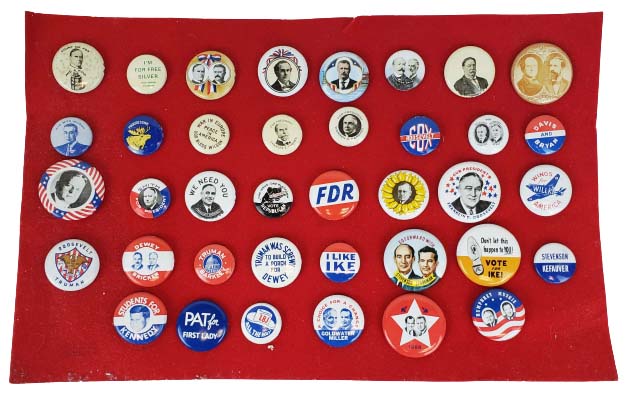
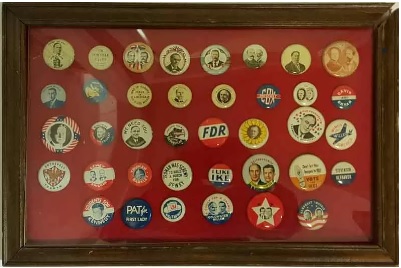
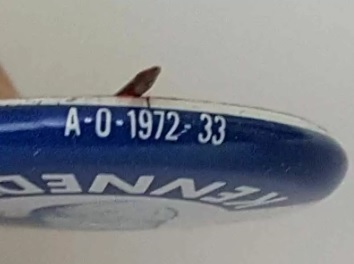
* GREAT QUOTATIONS INC. In 1988 a company called Great Quotations Inc. produced a framed set of 23 buttons under the title "United States Presidential Collectables 1900 to
1988. Perhaps most noteworthy is the notation at the lower left of the display "Authentic Reproductions" - an obvious oxymoron.
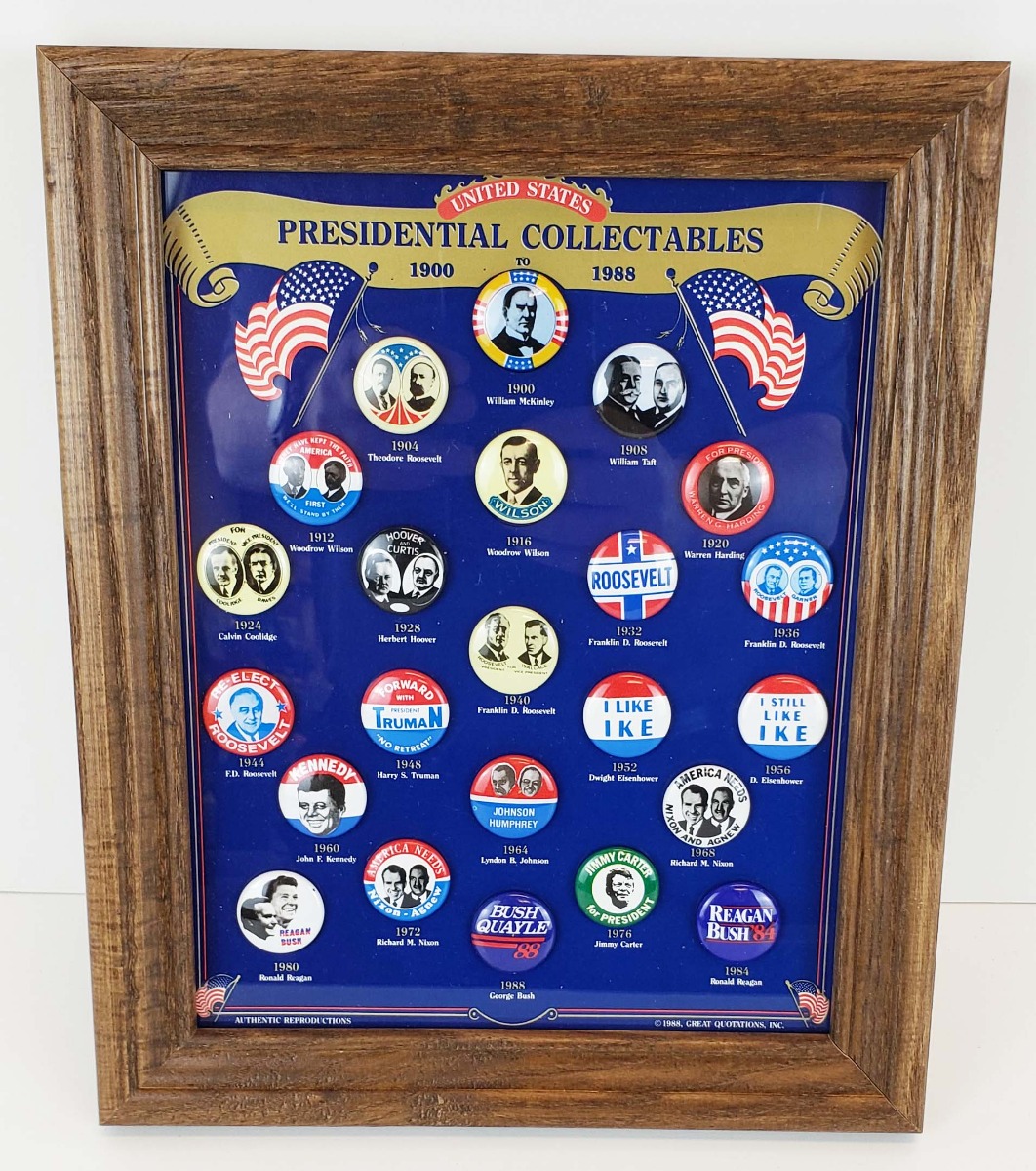

* CRACKERBARREL IN FARMINGDALE NEW YORK produced a series of campaign buttons. They were advertised as "Limited Edition" but at least included the word '"reproduction" clearly visible on the reverse side of the buttons. Below is a sample of just one of the many buttons in the set.
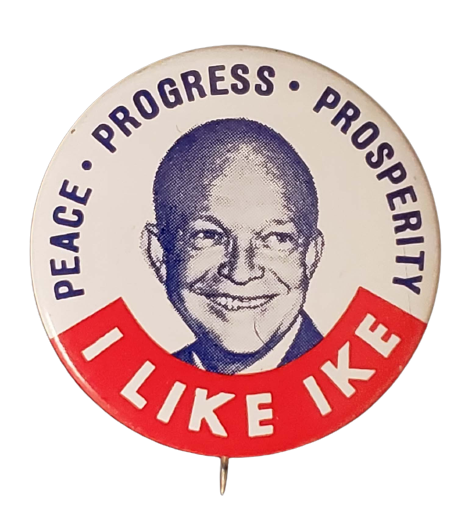
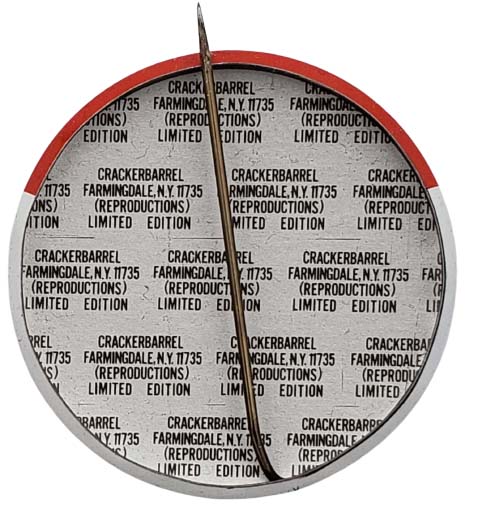
* KLEENEX TISSUES produced its own promotional set of political buttons. Most are dated '68 obviously a long way after president Theodore Roosevelt died. Here is a sample of of just one of the buttons Kleenex produced. Note, there is no mention of the buttons being reproductions, but they can all be identified by the Kleenex name.




